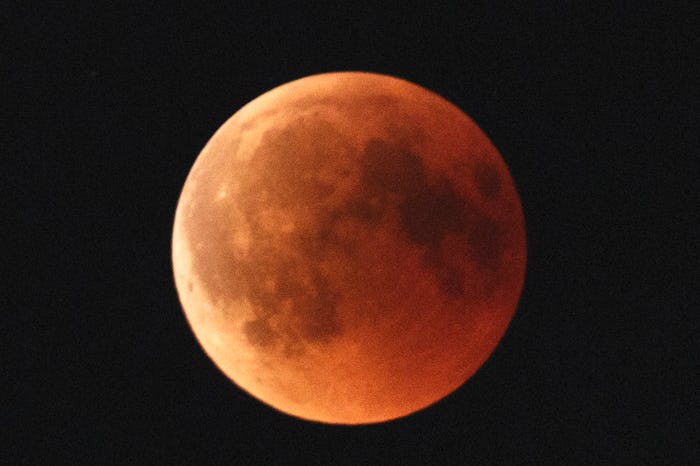Life

Do You Have To Stay Up Ridiculously Late To See The Super Blood Wolf Moon?
So you thought there wouldn't be anything exciting to spot in the sky once Santa's sleigh made its rounds a few weeks ago? Think again. Both professional astronomers and amateur stargazers (myself included) are incredibly psyched about the first astronomical phenomenon of 2019: a supermoon coinciding with a total lunar eclipse, making for a huge and colorful nighttime display. So what time is the Super Blood Wolf Moon taking place? That's the best part of all: You'll be able to see it without losing too much sleep.
First, a little explanation. On Sunday, January 20, the first full moon of the year will rise. When that happens, it's called a "supermoon," because it occurs during a lunar perigee, as the moon's orbit brings it closer than usual to the Earth and it appears larger than normal, according to NBC News. To make things even more interesting, this big moon will undergo an eclipse visible before midnight throughout the US, noted Space.com. It's not often a total lunar eclipse can be seen so early across all six American time zones, so we're lucky to be able to catch it now.
A lunar eclipse occurs when the Earth comes between the sun and moon, casting a shadow across the moon for a period of time before the sun's rays once again illuminate it. The dust and ash emitted from our planet help scatter the sun's rays, creating a rusty tint on that shadow and making the moon appear a striking red color — hence the term "blood moon."
Space.com gives a complete timetable of the hours in which the eclipse will be visible, depending on where you live. States in the Eastern Time Zone will start to see the moon darken around 10:34 p.m., so Central Zone states will see it at 9:34, Mountain Zone states at 8:34, Pacific Zone states at 7:34, and Alaska at 6:34. Hawaiian residents will start seeing the eclipse at 6:41 in their zone, when the moon will already be partly dark.
By 12:13 a.m. Eastern Time, the moon will be in mid-eclipse, meaning the entire surface will be in shadow and awash in red. (In other words: Get your cameras and cell phones out.) Again, that translates to 11:13 Central, 10:13 Mountain, 9:13 Pacific, 8:13 Alaska, and 7:13 Hawaii. NASA places the time of the total eclipse at 12:12 EST, however, so if you're a stickler for accuracy, get outside a few minutes early just to be on the safe side. Then the shadow will gradually move away as the Earth and moon continue orbiting.
By 2:48 a.m. Eastern Time, the moon will have exited the penumbra, or the final shadow stage, and the eclipse will be officially over.
Even if you're an early-to-bed type, it's still worth your while to make an exception and stay up to catch this stunning sight. As Time and Date reported, this will be the only total lunar eclipse of the year (a partial lunar eclipse will occur on July 16), and we won't see another blood moon until May 26, 2021.
Conveniently enough, the full moon eclipse is happening on the day before the Martin Luther King, Jr. holiday, when most schools are closed — meaning that you can watch it with your kids and let them sleep in the next day. They'll be awed at the unexpected appearance of the Super Blood Wolf Moon, not to mention its cool name. (The full moon in January is called the Wolf Moon, explained the Old Farmer's Almanac, because Native American tribes often heard hungry wolves howling at night in the dead of winter.)
So mark your calendar for the 20th and make a note of when the full moon eclipse will start in your time zone. Folks in the East and Midwest might be just a little bleary-eyed in the morning, but what's a little sleep deprivation compared to witnessing one of the world's most impressive phenomena?
After experiencing a traumatic c-section, this mother sought out a doula to support her through her second child’s delivery. Watch as that doula helps this mom reclaim the birth she felt robbed of with her first child, in Episode Three of Romper's Doula Diaries, Season Two, below. Visit Bustle Digital Group's YouTube page for more episodes, launching Mondays in December.